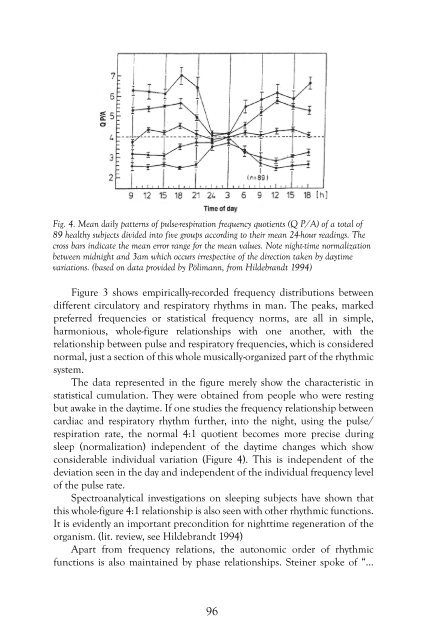When Healing Becomes Educating, Vol. 1 - Waldorf Research Institute
When Healing Becomes Educating, Vol. 1 - Waldorf Research Institute
When Healing Becomes Educating, Vol. 1 - Waldorf Research Institute
You also want an ePaper? Increase the reach of your titles
YUMPU automatically turns print PDFs into web optimized ePapers that Google loves.
Fig. 4. Mean daily patterns of pulse-respiration frequency quotients (Q P/A) of a total of<br />
89 healthy subjects divided into five groups according to their mean 24-hour readings. The<br />
cross bars indicate the mean error range for the mean values. Note night-time normalization<br />
between midnight and 3am which occurs irrespective of the direction taken by daytime<br />
variations. (based on data provided by Pölimann, from Hildebrandt 1994)<br />
Figure 3 shows empirically-recorded frequency distributions between<br />
different circulatory and respiratory rhythms in man. The peaks, marked<br />
preferred frequencies or statistical frequency norms, are all in simple,<br />
harmoni ous, whole-figure relationships with one another, with the<br />
relationship between pulse and respiratory frequencies, which is considered<br />
normal, just a section of this whole musically-organized part of the rhythmic<br />
system.<br />
The data represented in the figure merely show the characteristic in<br />
statistical cumulation. They were obtained from people who were resting<br />
but awake in the daytime. If one studies the frequency relationship between<br />
cardiac and respiratory rhythm further, into the night, using the pulse/<br />
respiration rate, the normal 4:1 quotient becomes more precise during<br />
sleep (normalization) independent of the daytime changes which show<br />
considerable individual variation (Figure 4). This is independent of the<br />
deviation seen in the day and independent of the individual frequency level<br />
of the pulse rate.<br />
Spectroanalytical investigations on sleeping subjects have shown that<br />
this whole-figure 4:1 relationship is also seen with other rhythmic functions.<br />
It is evidently an important precondition for nighttime regeneration of the<br />
organism. (lit. review, see Hildebrandt 1994)<br />
Apart from frequency relations, the autonomic order of rhythmic<br />
functions is also maintained by phase relationships. Steiner spoke of “...<br />
96

















